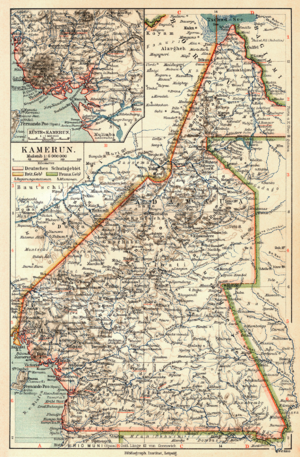List of colonial governors of Cameroon facts for kids
Cameroon, a country in Africa, has a rich history, especially its time under colonialism. From the late 1800s until 1960, different European powers controlled Cameroon. During this time, special leaders called colonial governors were in charge. They managed the country for their home governments.
This article tells you about these governors. It covers when Germany ruled Cameroon (called Kamerun), when France and the United Kingdom took over after World War I, and when Cameroon became a special territory managed by the League of Nations and later the United Nations.
Contents
German Rule in Kamerun (1884–1916)
Germany was the first European country to officially take control of Cameroon. This happened in 1884. They called the territory "Kamerun." The leaders Germany sent to govern Kamerun were called "Commissioners" or "Governors." Their job was to manage the land, its people, and its resources for the German Empire.
The first German official was Gustav Nachtigal. He signed treaties that made Kamerun a German colony. Over the years, many governors followed, each playing a role in shaping the colony. Their rule lasted until World War I.
| Time in Office | Portrait | Name | Role |
|---|---|---|---|
| 14 July 1884 to 19 July 1884 |  |
Gustav Nachtigal | First Commissioner |
| 4 July 1885 to 14 February 1891 |  |
Julius von Soden | Governor |
| 15 April 1891 to 13 August 1895 |  |
Eugen von Zimmerer | Governor |
| 13 August 1895 to 9 May 1907 |  |
Jesko von Puttkamer | Governor |
| 9 May 1907 to 27 August 1910 |  |
Theodor Seitz | Governor |
| 28 August 1910 to 29 January 1912 |  |
Otto Gleim | Governor |
| 29 January 1912 to 4 March 1916 |  |
Karl Ebermaier | Last German Governor |
Allied Occupation (1914–1919)
During World War I, Great Britain and France fought against Germany. They also fought for control of Germany's colonies, including Kamerun. This conflict in Africa was called the Kamerun campaign. By 1916, German forces in Cameroon surrendered.
After Germany's defeat, British and French military leaders took over the administration of Cameroon. They managed the territory until a formal decision was made about its future.
In 1919, Cameroon was officially divided. A larger part went to France, and a smaller part went to the United Kingdom.
French Cameroon (1916–1960)
After World War I, the League of Nations (a group of countries working for peace) decided that France would manage most of Cameroon. This was called a "mandate" territory. Later, after World War II, it became a "United Nations trust territory." This meant France was supposed to help Cameroon prepare for independence.
French officials, first called "Administrators" or "Commissioners," and later "High Commissioners," governed French Cameroon. They oversaw the development and daily life of the territory.
| Time in Office | Portrait | Name | Role |
|---|---|---|---|
| 7 April 1916 to 8 October 1916 |  |
Joseph Gaudérique Aymerich | Administrator |
| 6 March 1919 to March 1923 |  |
Jules Carde | Commissioner (League of Nations Mandate) |
| 29 April 1923 to 31 August 1932 | Théodore Paul Marchand | Commissioner | |
| 31 August 1932 to 7 July 1934 | Paul Auguste François Bonnecarrère | Commissioner | |
| January 1937 to 16 November 1938 | Pierre François Boisson | Commissioner | |
| 27 August 1940 to 20 November 1940 |  |
Philippe Leclerc de Hauteclocque | Governor |
| 16 March 1946 to 25 March 1947 | Robert Delavignette | High Commissioner (UN Trust Territory) | |
| April 1947 to 7 July 1949 | René Hoffherr | High Commissioner | |
| 10 January 1950 to 2 December 1954 | Jean Louis Marie André Soucadoux | High Commissioner | |
| 2 December 1954 to 17 April 1956 | Roland Joanes Louis Pré | High Commissioner | |
| 17 April 1956 to 29 January 1958 |  |
Pierre Messmer | High Commissioner |
| 19 February 1958 to 1 January 1960 | Xavier Antoine Torre | Last French High Commissioner |
French Cameroon gained its independence on January 1, 1960, becoming the Republic of Cameroon.
British Cameroon (1916–1961)
The United Kingdom also received a part of Cameroon to manage, first as a League of Nations mandate and then as a UN trust territory. This area was known as British Cameroons. It was administered as part of Colonial Nigeria.
The British officials in charge were called "Residents" or "Senior Residents," and later "Commissioners." They worked to govern the territory and prepare it for its future.
British Cameroons did not become independent as one country. In 1961, the northern part joined Nigeria, and the southern part joined the newly independent Republic of Cameroon.
After Independence
After 1960 and 1961, Cameroon became a fully independent nation. Its leaders are now chosen by its own people.
- To learn about the leaders of Cameroon after independence, see: List of presidents of Cameroon
See also




